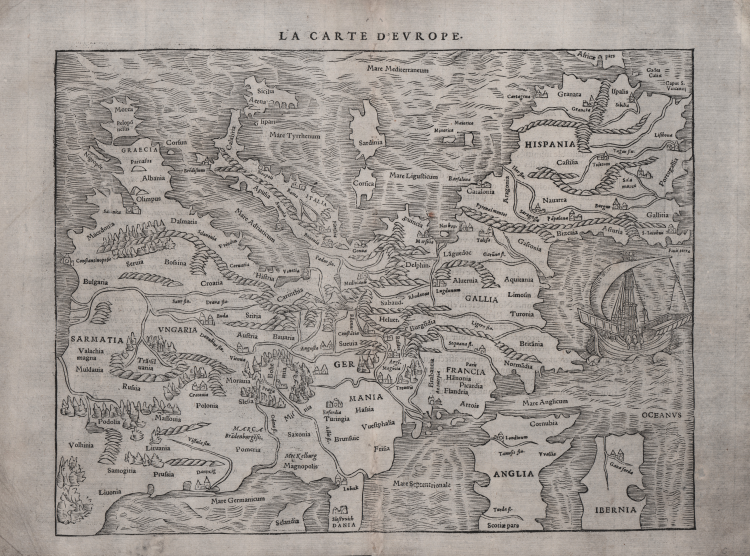




| Reference: | S22245 |
| Author | Guillaume GUEROULT |
| Year: | 1552 |
| Zone: | Europe |
| Printed: | Lyon |
| Measures: | 335 x 255 mm |



| Reference: | S22245 |
| Author | Guillaume GUEROULT |
| Year: | 1552 |
| Zone: | Europe |
| Printed: | Lyon |
| Measures: | 335 x 255 mm |
Early and very rare map of Europe by Guillaume Guéroult, after Sebastian Munster (1550).
This intriguing depiction of Europe oriented with south at the top was unusual even for its early period. Though unusual and even quaint to the modern eye, the map’s orientation was neither an error nor a regression, but in fact an indication of its modernity. Maps based on Ptolemaic sources shared the second-century geographer’s northern orientation. However, regional maps printed in Germany in the first part of the 16th century for the use of travelers were oriented to the south in order to be used in conjunction with a solar compass. Since these represented Munster’s most accurate and detailed modern sources, his maps derived from them virtually all shared the same orientation.
Most important among Munster’s sources was Martin Waldseemuller’s 1511 Carta itineraria europae, a four-sheet wall map of Europe, which in turn was heavily influenced by the 1500 and 1501 traveler’s maps of Erhard Etzlaub. While Waldseemuller’s grand work includes considerably more detail than Munster’s much smaller map, its influence both in terms of scope and orientation is unmistakable. The 1511 Carta itineraria europae has survived in a single copy of its 1520 edition; the only other derivative of the map is Munster’s extremely rare 1536 Tabula Europa, which was the precursor to his Moderna Europae Descriptio.
Guillaume Guéroult (1507-1569) ran the print shop of his brother-in-law Balthazar Arnoullet (1517-1556) in Lyon, at which he printed in 1552 the "Premier livre des figures set pourtraitz des villes plus illustre set renommées d'Europe" containing 9 town views/maps, mostly copied from Sebastian Muenster's "Cosmographia".
This example comes from the work that Guéroult and Arnouellet published the following year, in 1553, under the title "Epitome de la Corographie d'Europe, illustré de pourtraitz des villes plus renomées d'icelle." The town maps/views were increased to 21 and some maps added.
The plates were later reprinted, with variations in ornamental frames and minor changes, by B. Bonhomme (1557), Dupinet (1564) and F. Belleforest (1575).
Woodcut, in excellent condition.
Guillaume GUEROULT (1507-1569)
|
Guillaume Guéroult (Rouen, 1507 - Lyons, October 7, 1569) was a French publisher, translator and poet. An editor with a troubled and dissolute life, as well as a restless character, Guéroult is considered one of the greatest French printers of the Renaissance. Born in Rouen in 1507, in his youth he acquired a good knowledge of classical languages and, after finishing his studies, he began the art of printing with his uncle, Guillaume-Simon Du Bosc, a bookseller-printer from Rouen. Guéroult adheres to the Reformation together with his uncle around 1540 and in this period writes paragraphs of the Psalms and religious poems already sung and already circulating in manuscripts, before being published in his collection Chansons spirituelles of 1548. Guéroult leaves Rouen to live as a proofreader in Paris and Lyon, cities where printing flourished, as had his uncle, who had been driven out because of the constant harassment and persecution of printers and the reformed. Staying in Lyon he has the opportunity to be appreciated in literary circles, among poets, publishers and engravers. Very active and esteemed, starting from this moment he prepares, on behalf of various libraries, translations or works that will see the light only later.
|
Guillaume GUEROULT (1507-1569)
|
Guillaume Guéroult (Rouen, 1507 - Lyons, October 7, 1569) was a French publisher, translator and poet. An editor with a troubled and dissolute life, as well as a restless character, Guéroult is considered one of the greatest French printers of the Renaissance. Born in Rouen in 1507, in his youth he acquired a good knowledge of classical languages and, after finishing his studies, he began the art of printing with his uncle, Guillaume-Simon Du Bosc, a bookseller-printer from Rouen. Guéroult adheres to the Reformation together with his uncle around 1540 and in this period writes paragraphs of the Psalms and religious poems already sung and already circulating in manuscripts, before being published in his collection Chansons spirituelles of 1548. Guéroult leaves Rouen to live as a proofreader in Paris and Lyon, cities where printing flourished, as had his uncle, who had been driven out because of the constant harassment and persecution of printers and the reformed. Staying in Lyon he has the opportunity to be appreciated in literary circles, among poets, publishers and engravers. Very active and esteemed, starting from this moment he prepares, on behalf of various libraries, translations or works that will see the light only later.
|